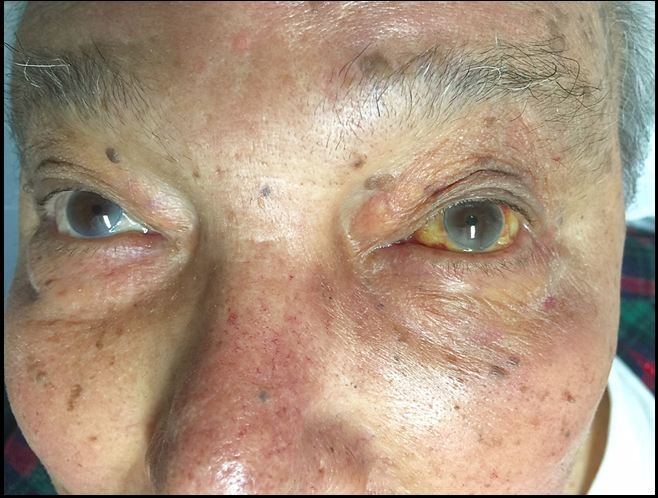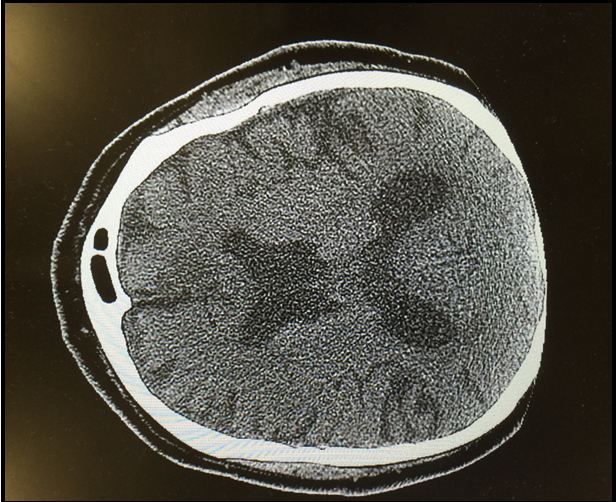- Clinical Technology
- Adult Immunization
- Hepatology
- Pediatric Immunization
- Screening
- Psychiatry
- Allergy
- Women's Health
- Cardiology
- Pediatrics
- Dermatology
- Endocrinology
- Pain Management
- Gastroenterology
- Infectious Disease
- Obesity Medicine
- Rheumatology
- Nephrology
- Neurology
- Pulmonology
Unilateral Scleral Jaundice in an Elderly Man: An Odd Finding
Left scleral icterus is the only prominent physical finding in the 86-year-old who presented with transient aphasia, ataxia, and general asthenia. Can you dx?
Figure 1. Unilateral scleral jaundice; click to enlarge.

Figure 2. CT head; click to enlarge.

An 86-year-old overweight man came to the emergency department (ED) accompanied by his daughter and spouse. He walked into the ED with steady gait. His chief complaint was generalized weakness. The family reported that he had been exhibiting strange behavior for the past 24 hours. His wife said that he had awoken with weakness the day before and had answered questions using only “yes” or “no.” His behavior was out of character that day and he had lost his balance in church multiple times. The symptoms lasted a few hours then gradually abated in intensity. The family called his primary care physician who advised ED evaluation. His past medical history included hypertension, arthritis, atrial fibrillation, dyslipidemia, dementia, GERD, and cardiac pacemaker placement.
On physical examination, left scleral jaundice was noted (Figure 1). He had no visual acuity deficit and EOM was within normal limits. He was alert and oriented x3. His strength was normal with no sensory or neurologic deficit. All other exams revealed no pertinent findings. Values obtained for CBC, BMP, troponin, BNP, UA, PT/INR and PTT were all within normal limits. Chest x-ray revealed cardiomegaly with slight pulmonary congestion. Pacemaker spikes were observed on ECG with no new findings. Based on the neurologic signs and symptoms, CT of the head was performed; the image is seen in Figure 2.
What is your diagnosis?
Please leave your thoughts below; click here for answer and discussion.
Answer: Unilateral scleral icterus with acute stroke
Discussion:
Unilateral scleral icterus is a very rare finding and the etiology remains unknown. We could find only one case of unilateral scleral jaundice with acute stroke in the literature, reported by Krishnan et al.1 It has been proposed that increased vasomotor tone on the hemiplegic side in patients with ischemic stroke may lead to reduced blood flow on the side opposite to the infarction. However, our patient had jaundice on the same side he had experienced acute stroke. Jaundice in a monocular patient with glass eye may be confusing and should be considered as differential diagnosis. Page and colleagues have described two cases of ipsilateral edema and contralateral jaundice associated with hemiplegia and cardiac decompensation.2 Asymmetric jaundice has been described with edema following portacaval anastomosis3 but in these cases the edema and jaundice both occur on the same side-a result of binding of bilirubin to the albumin of ascitic fluid that dissects into subcutaneous spaces. Meakins4 has reported localized pigmentation in patients with circulatory failure. In his series of six cases all patients had yellow discoloration on the upper torso, face, and upper limbs only. Our patient had no clinical evidence of heart failure or cirrhosis.
To our knowledge this case is only the second report of unilateral icterus associated with acute stroke and is of significance in presentation and clinical findings. It reminds us once again of the importance of history and physical exam which remain cornerstones in evaluation and management of patients.
References:
1. Krishnan P, Mishra R, Jena M, Kartikueyan R. An unusual case of unilateral scleral icterus. Oman J Ophthalmol. 2015;8:76–77.
2. Page IH. Ipsolateral edema and contralateral jaundice associated with hemiplegia and cardiac decompensation. Am J Med Sci. 1929;177:273–6.
3. Conn HO. Unilateral edema and jaundice after portacaval anastomosis. [Brief communication] Ann Intern Med. 1972;76:459–61.
4. Meakins J. Distribution of jaundice in circulatory failure. J Clin Invest. 1927;4:135–48.
Suggested reading
Korpelainen JT, Sotaniemi KA, Myllyla VV. Asymmetrical skin temperature in ischemic stroke. Stroke.1995;26:1543–7.
